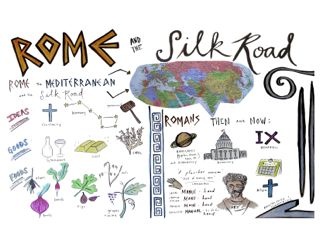Kitchen Humanities: Silk Road III - Fresh Pasta with Fresh Herbs

Summary
In this 6th grade humanities lesson, students prepare fresh pasta with Gremolata as they study the exchange of ideas, goods, and foods between Rome and other regions along the Silk Road. This is the third of four Silk Road lessons.
Objectives
After this lesson, students will be able to:
- Cite examples of Rome’s contribution to the Silk Road
- Discuss the legacy of the Roman Empire
- Make connections between the diets of historic cultures and foods we eat today
Assessments
During this lesson, students will:
- Answer questions about the spread of Roman ideas, goods, and food throughout countries on the Silk Road
- Cite examples of Roman art, architecture, technology, science, literature, languages, and law in modern society
- Make connections between the diets of historic cultures and foods we eat today
Materials
For the Chef Meeting
- Homemade Hand Rolled Pasta recipe
- Gremolata recipe
- Ingredients and tools for demonstration
- Traditional Italian music recording
- Music player
- Visual aid
Ingredients
For the Homemade Hand Rolled Pasta
- Pasta flour
- Salt
- Eggs
- Olive oil
For the Gremolata
- Italian parsley
- Garlic
- Lemon
Tools
- Stockpot
- Mixing bowl
- Zester
- Grater
- Crinkle cutter
- Spider strainer
- Pasta crimper
- Rolling pins
- Bench scraper
- Chefs’ knives
- Paring knives
- Cutting boards
- Measuring cups
- Measuring spoons
- Forks
Equipment
- Stove
Before You Begin
- Collect all the tools and ingredients, and then distribute them to the tables
- Gather supplies for the Chef Meeting
- Create the visual aid
- Copy the Homemade Hand Rolled Pasta recipe to hand out
- Copy the Gremolata recipe to hand out
- Select music and set up the audio player
- Prepare pasta dough (if possible, use dough made in an earlier class)
Procedures
At the Chef Meeting
- Play music as students silently enter the classroom.
- Welcome students and introduce Rome as the final stop on their Silk Road journey. Remind them of the long trip through China and India, and ask for examples of important goods, ideas, and foods from each region that were traded on the Silk Road. Have students recall the foods they prepared in class when studying those regions.
- Explain that Rome was the Great Empire of the Western world. It began in Italy and expanded to include most of Europe, North Africa, Egypt, and Syria over a period of 500 years. The Roman Empire became part of the Silk Road 200 years after China. Subsequently, silk became a symbol of wealth to the Romans.
- Discuss some of the foods eaten during the Roman Empire. Introduce today's recipe, Homemade Hand Rolled Pasta with Gremolata.
- Trace the Silk Road on the visual aid, and ask students to identify ideas, goods, and foods that Romans contributed to trade along its route.
- Ask students to define the phrase cultural influence, and to identify examples of Roman influence that exist in our culture today. Point out the Roman contributions that are illustrated on the visual aid: our calendar, Roman numerals, planet names, elements of architecture, and features of the United States Government.
- Explain that the written constitution, tripartite government, system of checks and balances, and civic duty requirement are all characteristics of the United States Government that were influenced by similar parts of the Government of the Roman Republic.
- Review the recipes and demonstrate how to make the dough directly on the table or in a mixing bowl.
-
Ask students to wash their hands and join their
table group.
At the Table
- Meet with the table groups to review the recipes and assign jobs.
- The table group should be divided into three working groups. The first group of students rolls, cuts, and cooks the pasta using previously prepared pasta dough. The second group of students prepares pasta dough for the following class. The third group of students grates cheese and prepares the Gremolata.
- Set the table; eat; clean up.
At the Closing Circle
Ask
students to cite one example of Roman influence in contemporary society.
Vocabulary
Cultural influence